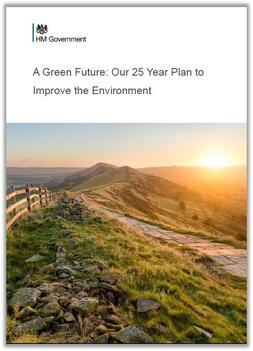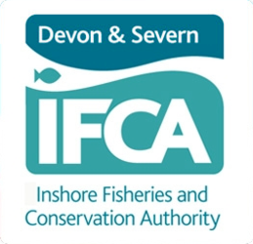25 Year Environment Plan
- Home
- Environment & Research
- Marine Environmental Matters
- 25 Year Environment Plan
Page review/updated 04/12/2024
(Content of page last updated: 30th September 2021)
25 YEAR ENVIRONMENT PLAN

In January 2018, the UK Government launched its 25 Year Environment Plan (25YEP). Broadly, the objectives of this plan are to achieve:
- clean air,
- clean and plentiful water,
- a growing and resilient network of land, water and sea that is richer in plants and wildlife
- reduced risks of harm from environmental hazards (such as floods and coastal erosion),
- more sustainable and efficient use of resources from nature (such as fish and timber),
- enhanced beauty and environmental value of our natural spaces.
The 25YEP also commits to:
- mitigate climate change while adapting to reduce its impact,
- minimise waste,
- manage environmental exposure to chemicals, and
- enhance biosecurity.
To achieve these objectives, the UK Government has committed to enhancing the ‘natural capital’ of the UK, which is essential for economic growth and productivity over the long term (see Box 1). Below is an outline of the background to the 25YEP, some key policy areas that relate to inshore fisheries and conservation, and information on progress and implementation of the 25YEP.
Box 1: What is natural capital?
The term ‘natural capital’ encompasses all of the natural assets from which we benefit, and includes both the living and non-living aspects of ecosystems. These benefits we get from natural capital are often called ecosystem services, and they support all life on earth. Ecosystem services range from improving the air we breathe and providing the food we eat, to nutrient cycling, climate regulation, and the provision of medicine and raw materials. Ecosystem services also include a variety of cultural, recreational and spiritual benefits. Natural capital assets are seen as the original source of all other types of capital (financial, social or otherwise).
Adopting a ‘natural capital approach’ to decision making, as advocated by Defra’s Enabling a Natural Capital Approach guidance (2020), allows developers and managers to think of nature as a set of assets that benefit people, and provides a framework for environmental, social and economic information to be presented with equal weighting in plans and projects. A natural capital approach reduces the risk of undervaluing the natural environment, enables a more comprehensive cost-benefit analysis and risk assessment and helps to maximise the long-term gain from natural capital assets. It also allows regulators to embed an ‘environmental net gain’ principle for development, which seeks to leave the environment in a better state than it was found while encouraging development.
BACKGROUND
In October 2014, the UK Government endorsed a proposal made by the Natural Capital Committee (an independent advisory committee to the Government), that there should be a 25-year framework for maintaining and improving Natural Capital. A commitment to a 25-year plan was therefore included in all versions of the Department for Environment, Food and Rural Affairs’ (Defra’s) single departmental plan that have been published since 2016. The final plan ‘A Green Future: Our 25 Year Plan to Improve the Environment’ was published in January 2018, based in part on advice and recommendations provided by the Natural Capital Committee. Key policy areas are highlighted below.
The Plan sits alongside two other key strategies:
The Industrial Strategy (‘for boosting UK productivity’) and the Clean Growth Strategy (‘a blueprint for Britain’s low carbon future’), and was accompanied by three annexes:
- Annex 1 contains further context and evidence underpinning the 25YEP
- Annex 2 lists some Government strategies and plans to protect and conserve the environment
- Annex 3 lists some of the UK’s international environmental obligations
The 25YEP as a whole relates only to areas for which HM Government is responsible, reflecting the devolved nature of a lot of environmental policy. Therefore, some aspects of the 25YEP relate to England only, while others relate to the UK in its entirety. The Government intends to update the 25YEP at least every 5 years, and to report annually to Parliament on progress against the 25YEP objectives.
KEY POLICY AIMS AND ACTIONS RELEVANT TO UK INSHORE FISHERIES AND CONSERVATION
The 25YEP includes the following broad aims for the Government to achieve:
1. Securing clean, healthy, productive and biologically diverse seas and oceans, by:
- Implementing a sustainable fisheries policy (based on an ecosystem approach to fisheries management) as we leave the Common Fisheries Policy: allowing sustainable fishing while protecting and enhancing the wider marine environment.
- Achieving good environmental status of our seas while allowing marine industries to thrive.
- Completing our ecologically coherent network of well-managed marine protected areas (MPAs) via designation of a third tranche of Marine Conservation Zones (MCZs).
- Taking a new ‘Whole Site Approach’ to MPAs of greatest biodiversity interest, recognising the interdependence of many species and habitats and extending protection to wider ecosystems, processes and functions rather than focusing on individual habitats or features.
- Putting in place the remaining Marine Plans by 2021.
2. Protecting and improving our global environment, by
- Leading by example in tackling climate change and protecting and improving biodiversity. This is important, because climate change is likely to have a major impact on biodiversity and fisheries.
- Leaving a smaller environmental footprint by enhancing sustainability.
- Delivering the United Nations’ Sustainable Development Goals, reducing the UK’s environmental impact at home and abroad.
3. Using and managing land sustainably, including
- Embedding an ‘environmental net gain’ principle for development, which aims to ensure all developments have a net positive effect on the natural environment.
- Introducing new farming rules for water and fertilisers in agriculture, which is relevant for nutrient run-off and its effects on the marine environment, including fish.
- Reducing the risks from flooding and coastal erosion.
4. Increasing resource efficiency and reducing pollution and waste, including
- Achieving zero avoidable plastic waste by 2042.
- Encouraging the development of bio-based and biodegradable plastic.
- Reducing demand for single-use plastic.
- Improving recycling.
- Tackling marine plastics at an international level.
- Helping to address the control and prevention of ship-source pollution.
- Reducing the impact of wastewater and chemical pollution.
5. Connecting people with the environment to improve health and wellbeing, by encouraging engagement with ‘green and blue spaces’
PROGRESS AND IMPLEMENTATION
The first 25YEP Progress Report was published in March 2019, but was criticised by the Natural Capital Committee for failing to provide an assessment on whether England’s natural environment has improved. The Natural Capital Committee highlighted some “worrying evidence of declines in our natural environment”, and urged the establishment of a baseline census of the state of England’s natural capital.
Some progress is being made towards the objectives of the 25YEP. For example, priorities set out in the 25YEP will benefit from the establishment of regional Marine Plans (including the South West Marine Plans), and from the establishment and management of the latest tranche of Marine Conservation Zones, of which six reside in D&S IFCA’s District.
In addition, Defra has established four “Pioneer” projects to aid the development and implementation of the 25 Year Environment Plan, including a ‘Landscape Pioneer’ and a ‘Marine Pioneer’ in North Devon. The North Devon Marine Pioneer has been exploring how marine Natural Capital can best be managedfor the benefit of the environment, economy and people. The ‘Lessons Learned’ from the North Devon Marine Pioneer are available to download here.
The Natural Capital and Whole Site Approaches advocated by Defra and in the 25YEP are complementary to managing the marine environment within an ecosystem approach that accounts for the many diverse human and natural impacts on the marine environment. Defra has set up working groups to progress the details on how the whole site and ecosystem approaches will be developed and implemented. An ecosystem approach to fisheries management would consider not only the effects of fishing on fish stocks and the wider marine environment, but also the in-combination effects on fish stocks and the environment of marine and terrestrial activities and installations such as aggregate dredging, coastal power stations and renewable energy generation, farming and coastal development. D&S IFCA is developing Fisheries Research and Management Plans that will provide a first step towards a local application of the ecosystem approach to fisheries management.
